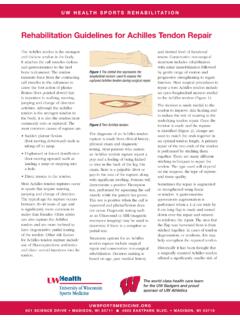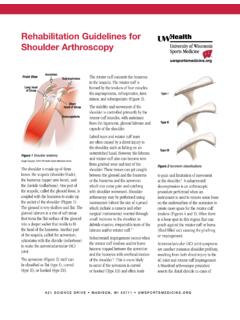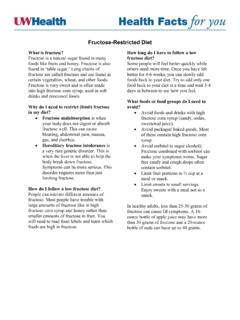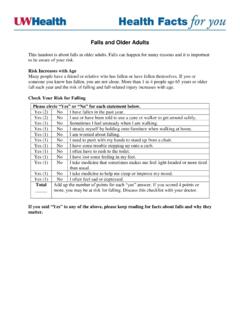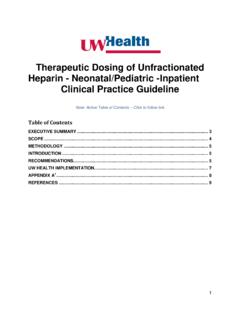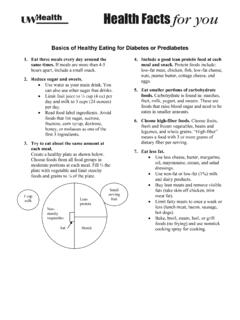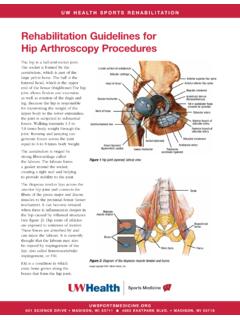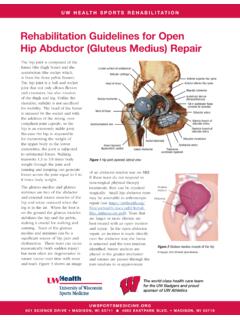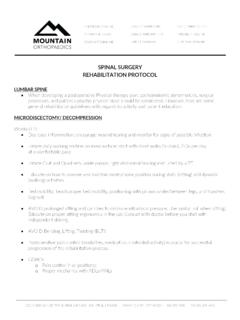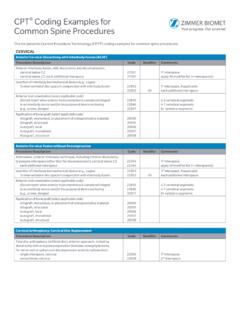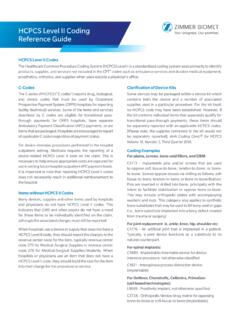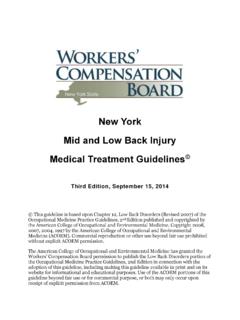Transcription of Rehabilitation Guidelines for Lumbar Spondylolysis ...
1 Rehabilitation Guidelines for Lumbar Spondylolysis /Spondylolisthesis The Lumbar spine consists of five stacked bones (vertebra). Spondyloysis (spon-dee-low-lye-sis) is defined as a stress fracture defect of the pars and can occur on the left, right or both sides of the bone. The vast majority of these injuries are at the L5 bone, with the L4 level being the second most likely to be affected. Spondylolysis occurs in 6-10% of the general population and has been found to be as high as 25-60% of the athletic population.(1,2) It is especially common in young athletes under the age of 18, who participate in sports that involve twisting or backward bending motions of the spine.
2 This injury also runs in families and is more common in some populations suggesting that there might be a hereditary component. Understanding the InjuryAn x-ray, MRI, CT scan or bone scan can confirm the diagnosis and determine how new the injury is. The fracture line or the bony defect can be classified into various stages of acuity: early, progressive and terminal. In the early stage, bone edema might be a hairline fracture visible. In the progressive stage, the fracture may have progressed to a wider gap and in the terminal stage, the defect shows non-union, with little chance of healing.
3 Because of this, terminal stage defects can often progress more quickly through Rehabilitation . Not all Lumbar stress fractures heal. If the stress fracture is only on one side of the bone (unilateral) and is detected as soon as possible (early stage), the likelihood of healing is ~70%.(3) If diagnosis and rest are delayed (progressive or terminal stage) then healing rates decrease to 28%.(3) The likelihood of healing also goes down if fractures are present bilaterally (on both the left and the right side). Eighty-five percent of athletes report good/excellent clinical outcome by year one, regardless of the fracture healing or not.
4 (2)The Role of RehabilitationSpondylolysis creates relative instability of the Lumbar region. Rehabilitation focusing on specific training of muscles surrounding the Lumbar spine that provide stability can be very effective in reducing and preventing pain and instability. Figure 1 Stress fracture defect on the vertebraeUW HEALTH SPORTS REHABILITATIONThe world class health care team for the UW Badgers and proud sponsor of UW 621 SCIENCE DRIVE MADISON, WI 53711 4602 EASTPARK BLVD. MADISON, WI 53718 Figure 2: X-ray of the Lumbar spine showing Spondylolysis , decrease in disc space and bony spur formation (side view ) 621 SCIENCE DRIVE MADISON, WI 53711 4602 EASTPARK BLVD, MADISON, WI 53718 Guidelines for Lumbar Spondylolysis /Spondylolisthesis2 These muscles are the deep abdominal muscles (transversus abdominis and internal oblique) and the Lumbar multifidus.
5 Training of these stability muscles in the Lumbar spine provides a solid foundation for the athlete to integrate them into their sport-specific movement patterns. Exercises focusing on these muscles have been shown to significantly decrease pain and disability in people with Spondylolysis /spondylolisthesis. This training effect persists for many years following only 10 weeks of practice (4).Goals of Treatment1. Pain control2. Healing when possible3. Restoration of normal function including return to sportsConsequences of the InjuryJust like any bone fracture, stress fractures in the low back need time to heal.
6 This means resting from all sporting and impact activities until there is little, to no pain. This usually takes 4-8 weeks, but may take patients with a bilateral stress fracture, there is a rare complication where spinal alignment could be affected. This condition is called spondylolisthesis (spon-dee-low-lis-thee-sis). If a small amount of slip occurs, research reports that it is still safe to participate in competitive sports. However, if too much slippage occurs, the bones may begin to press on nerves and orthopedic surgery may be necessary to correct the condition.
7 Treatment OptionsThe recommended treatment program for Spondylolysis is usually a combination of the following: For early or progressive defects = rest/protection for the first 4 weeks, possibly longer: no sports participation, no physical education class, reduce backpack weight and avoid sleeping on your stomach (5) For terminal defects = a brief period of activity reduction prior to starting stabilization exercises (5) Pain medications as needed/recommended by your physician In addition to a calcium-rich diet, vitamin D is essential for bone health.
8 Your provider may test your vitamin D level and if it is low, suggest that you take a vitamin D supplement. Research shows that vitamin D deficiency likely exists in orthopaedic trauma patients living in northern latitudes.(7) In Nebraska, over 60% of adolescents with Spondylolysis were found to have low vitamin D levels.(8) Rehabilitation under the guidance of a physical therapist or athletic trainer. Corrective exercise training is emphasized- beginning with gentle upper and lower body stretching and progressing to an individualized core strengthening routine that gradually builds over time.
9 For most people a brace is not needed for this condition. Clinical outcome of patients treated with a brace to patients treated without a brace was not significantly different.(6) However, if 2-4 weeks of rest/activity restriction alone do not reduce the pain, then a brace may be beneficial. On rare occasions, orthopedic surgery should be considered when symptoms persist, there are associated nerve complications or there is a progressive slippage of the bone. In these cases, surgery can provide additional stabilization to the 3: X-ray of the Lumbar spine showing spondylolisthesis (posterior and side view)621 SCIENCE DRIVE MADISON, WI 53711 4602 EASTPARK BLVD, MADISON, WI 53718 Guidelines for Lumbar Spondylolysis /Spondylolisthesis3 Diagnostic StageThe process may include x-rays, If (-) result MRI, CT scan and/or bone SPECTRest StageRest, including no sports participation, recreational activities or physical education class.
10 Consider bracing if still symptomatic after 2-4 weeks Rehabilitation StageExercise Phase 1-2 FoundationalRange of MotionLow-impact aerobic conditioningNeutral spine StabilizationExercise Phase 2-3 RecoveryRange of motionAerobic conditioningResistive / strength trainingProgressive spinal stabilizationAssess kinetic chain and sport techniqueExercise Phase 3-4 FunctionalAerobic conditioningResistive /strength trainingDynamic, multi-planar spinal stabilizationSports specific retrainingSkill and technique refinement Return to Play StageExercise Phase 5 Full, painfree or nearly painfree ROMN ormal strength & aerobic fitnessImproved spinal awareness & mechanicsAble to perform sports-related skills without painSkill and technique refinementEarly/progressive defect in the pars interarticularisWeeks 0-8 Weeks 4-12 Weeks 8-16>8 weeks.
